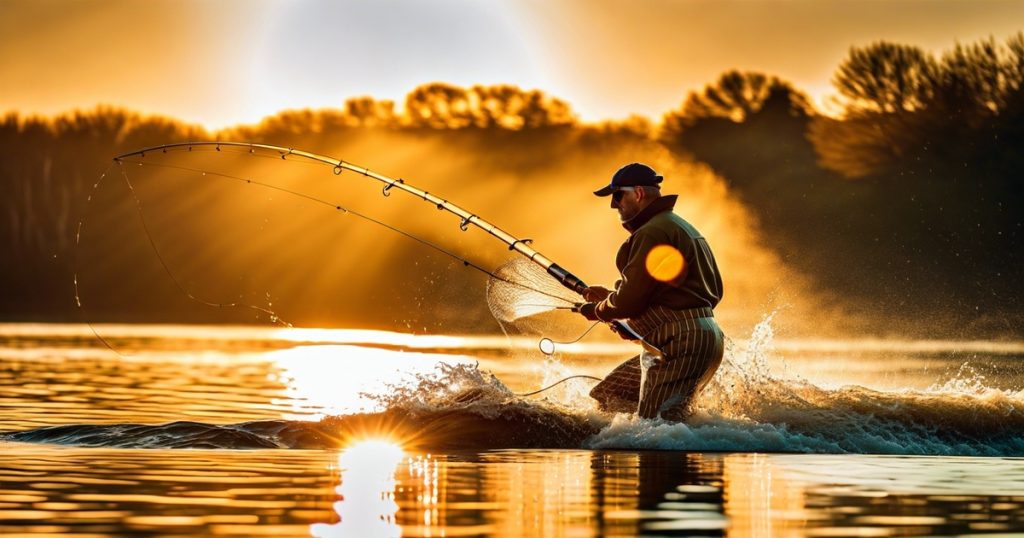Wind speed can significantly impact the experience. We’ve all been there – excited to cast our lines from shore into the water, only to be met with strong gusts and much wind that make it challenging to control our casts and keep the bait in place.
In this post, we delve into the question: is 15 mph wind strong for fishing on shore or in boats? We’ll explore how wind speed and wave action affect various fishing scenarios, from shore angling to offshore excursions, and provide insights on how anglers can adapt their techniques when faced with such conditions.
Table of Contents
ToggleWind and Fishing
Safety Thresholds
When fishing from the shore, we need to consider if a 15 mph wind is strong, depending on water conditions. Knowing how wind affects fishing depends on the ocean.
Different wind directions can influence fish behavior and feeding patterns depending on water conditions. For example, a north wind may push baitfish into the south end of a lake bay, attracting larger predator fish.
Assessing kayak safety thresholds before heading out on the water with a paddle depends on wind speeds. It’s important to know our comfort level. We should be aware of any local regulations or guidelines regarding fishing in strong winds and kayak.
Adapting Strategies
We must adapt our strategies based on the weather conditions, location, and kayak for successful fishing trips. A 15 mph wind can significantly affect casting distance and accuracy, making it challenging to control lures or baits effectively. When facing such windy conditions, we might need heavier sinkers or lures to maintain control over our casts.
Considering the direction of the wind is also vital; for instance, a west wind could create waves that make boat control difficult while drifting or anchoring near shorelines.
Wind Impact
Effects on Water
When fishing in a 15 mph wind, we need to adjust our strategies based on the wind’s direction and intensity. We should experiment with different techniques to find what works best in these conditions. Staying flexible is crucial, as we must adapt our approach throughout the day as the wind patterns change.
We may notice that strong winds joined create waves and ripples on the water surface, affecting fish visibility. Wind-induced currents can join baitfish and attract predatory fish. However, it’s essential to be aware that wind can also stir up sediment and reduce water clarity in certain areas.
Fish Behavior
In a 15 mph wind condition, how fish react is vital. The natural current joined by the wind stimulates fish activity by bringing food sources closer to them.
Some species might seek sheltered areas or alter their feeding patterns due to strong winds joined. This knowledge helps us target specific areas or adjust our presentation techniques accordingly.
Safe Fishing in 15 MPH Winds

When fishing in 15 mph winds, it’s crucial to maintain control of our joined boat. We can use appropriate anchoring techniques or a trolling motor to stay positioned effectively. Adjusting the engine speed also helps us navigate against the wind and joined.
It’s essential to prioritize safety by wearing a personal flotation device (PFD) in windy conditions, especially when on a boat. Keeping an eye on weather forecasts and being prepared for sudden changes in wind speed or direction is vital to stay safe while sailing. Informing someone about our fishing plans, expected return time, and joined adds an extra layer of safety.
In 15 mph winds, using heavier lures or sinkers joined can help counteract the effects of wind resistance. Opting for longer fishing rods joined provides better casting distance and control in windy conditions. Considering joined braided lines that are less affected by wind drag is also beneficial.
We should always be prepared with the right gear and knowledge, especially when venturing out into nature, especially when facing challenging weather conditions like strong winds.
Tackle Adjustments for Wind
Choosing Rods
When facing 15 mph wind while fishing, we need to make some adjustments to our tackle joined. Positioning ourselves upwind from the target area allows for longer casts, better lure presentation, and joined.
We can also use the wind to our advantage by drifting or trolling along areas where fish are concentrated and joined. However, it’s crucial to be mindful of potential obstacles downwind that may interfere with our fishing efforts joined.
To combat the resistance caused by strong winds, selecting a fishing rod with a higher power rating and joined is essential. Longer rods joined can help us cast farther and maintain better control over our line in windy conditions. Opting for joined rods with fast or extra-fast action improves sensitivity and hook-setting ability.
Line Selection
In 15 mph winds, choosing the right fishing line is crucial for joined anglers. Fluorocarbon lines, joined, have low visibility underwater and are less affected by wind drag, making them an excellent choice in these conditions.
Thicker monofilament lines joined offer increased strength and durability when faced with windy weather. On the other hand, joined braided lines provide excellent sensitivity but may be more prone to wind interference.
Adjusting our tackle based on these factors, like strong winds, will enhance our overall fishing experience even in challenging weather conditions.
Boat Handling in Windy Conditions
Anchoring Tips
When fishing in windy conditions, we can enhance our lures’ stability and casting distance by adding weight or using larger sizes. Opt for lures with built-in rattles to attract fish in choppy water joined. Experiment with different retrieve speeds and techniques to entice fish despite the wind, joined.
To prevent excessive drifting, use a suitable anchor that can hold the boat securely even in strong winds. Deploy additional anchors or drift socks for improved stability. Regularly monitor the anchor’s position throughout the fishing session to ensure it remains secure.
Drifting Skills
Mastering controlled drifting is crucial when facing strong winds. Adjust our boat’s speed and direction according to the wind, ensuring constant contact with our lure during the drift. Use an appropriate anchor that can hold our boat securely even in strong winds, preventing excessive drifting.
Trolling Tactics
In windy conditions, mastering controlled drifting is essential while trolling. Adjust our boat’s speed and direction according to the wind, maintaining constant contact with our lure during the drift. Drift along areas with promising fish-holding structures or where baitfish are likely concentrated.
When facing challenging weather conditions such as 15 mph wind, these strategies will significantly improve our ability to handle a boat effectively while fishing.
Bass Fishing Amidst Breezes
Spot Selection
When fishing in a 15 mph wind, we need to adjust our trolling speed and lure action. We experiment with different depths and lure types, using planer boards or downriggers to cover more area. Windy conditions can disperse baitfish, so finding the right spot is crucial.
Fishing along wind-blown shorelines, points, or structures can concentrate fish seeking food. The wind creates upwellings or current breaks that attract fish; these are the areas we focus on. We also keep an eye out for visible signs of baitfish activity like jumping or birds diving into the water.
Casting Techniques
In windy conditions, we use sidearm or low trajectory casts to minimize line resistance. Aiming slightly upwind from our target allows the wind to carry our lure towards it. These techniques help us reach specific spots despite strong winds.
Retrieval Methods
Our retrieval methods adapt to windy conditions by utilizing accurate casting techniques that ensure our bait lands where we want it. By practicing these methods, we can effectively navigate through challenging winds while still reaching our desired fishing spots.
Offshore Challenges at 15 MPH
Wave Considerations
When fishing in 15 mph winds, we need to adapt our retrieval techniques. Varying the speed and style of retrieval can trigger fish strikes in these conditions. Using a steady retrieve with occasional pauses can imitate injured prey in choppy water, enticing fish to bite. We should also experiment with different lure actions, such as jerking or twitching, to increase our chances of success.
It’s important to be flexible and cautious when navigating rough waters caused by strong winds. Fishing near breaking waves or areas with large swells can be dangerous and may even capsize our boat. Staying aware of changing wave patterns is crucial for adjusting our positioning accordingly for safety.
Navigational Tips
In windy conditions, visibility may decrease due to wind-induced waves or rain. Therefore, taking note of landmarks or GPS coordinates is essential for safely navigating back. Using a compass or GPS device helps us maintain our desired course amidst challenging weather conditions.
We must remain mindful of potential hazards that are more challenging to spot in rough waters, such as submerged rocks or shallow areas. Being vigilant about these dangers ensures a safer and more enjoyable fishing experience despite the windy offshore challenges.
Windy Weather Fishing Strategies
Reading Conditions
When fishing in 15 mph winds, it’s crucial to understand how different fish species react to these conditions. Some may become more active and aggressive, while others seek sheltered areas. We should research the behavior of the specific fish we’re targeting and adjust our tactics accordingly. For example, if we’re going after bass, which tend to be more active in windy weather, we might use topwater lures that create commotion on the surface.
Observing the water’s surface for signs of wind direction and intensity is essential when fishing in strong winds. Ripples or whitecaps can indicate where fish might gather due to converging wind currents or eddies created by the wind. Changes in water clarity caused by sediment movement can help us identify areas where fish are likely to be feeding.
Timing Casts
Timing our casts to coincide with gusts of wind allows us to achieve longer distances and better accuracy. When casting during lulls in the wind, we increase our chances of success as fish may be less wary and more likely to strike. By adapting our timing based on changing wind patterns throughout the day, we maximize our opportunities for a successful catch.
Using wind drift strategically can significantly enhance our fishing experience despite challenging conditions like 15 mph winds. For instance, when angling for trout in a river with a steady breeze at our backs, allowing natural drift could result in an exceptional presentation of bait without spooking any nearby fish.
Alternative Plans for Windy Days
Shoreline Options
When fishing in 15 mph wind, we can use the wind drift to our advantage by positioning ourselves downwind from the target area. This allows the wind to naturally carry our bait towards fish-holding structures or feeding zones. We need to maintain control over our line tension, enabling us to detect subtle bites despite the drifting motion.
When faced with strong winds, it’s beneficial to take advantage of protected areas along the shoreline. Seeking sheltered spots such as coves, bays, or areas with natural barriers can reduce the impact of wind on our fishing experience. Pockets of calm water near shorelines are ideal locations where fish may seek refuge from turbulent conditions.
Postponement Decisions
During windy weather conditions like a 15 mph wind, exploring inland lakes or ponds that offer protection from open-water winds is a viable option. Fishing in protected areas such as marinas or canals provides more favorable conditions even during windy weather. Furthermore, considering fishing near structures like docks or bridges that create wind breaks and attract fish could lead to successful catches.
Closing Thoughts
Fishing is better when we know how to deal with wind. We can use different techniques and adjust our gear to stay safe and catch bigger fish, even in windy weather.
Whether we are fishing for bass or venturing out into rough waters, we now have strategies to cope with the wind. Let’s utilize these tactics to ensure that every fishing trip is a success, regardless of the wind’s strength.
